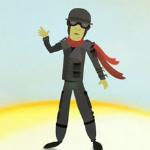
DOUG JOHNSON: Welcome to American Mosaic in VOA Special English.
(MUSIC)
I'm Doug Johnson.
Today we listen to a new album of songs by Shel Silverstein...
And answer a question about dinosaurs.
But first, we visit a website for children to explore the world of advertising.
(MUSIC)
Admongo
DOUG JOHNSON: The United States government has launched a website to help children think critically about the advertising that is aimed at them. The new site is called Admongo. It claims to provide visitors with an "ad-ucation" through games and other entertainment. Barbara Klein has our report.
BARBARA KLEIN: A cartoon man dressed in old time pilot clothing greets visitors to Admongo. "Call me Haiz" he says upon arrival in a rocket ship that opens up with a crazy world inside it. Spacey dance music plays in the background as Haiz tells visitors that they need to learn about advertising. Why, he asks? Because, he says, advertising is everywhere -- online, on television, even outside on buses and billboards.

The Admongo website is aimed at children eight to 12 years old. Its inventors say that is the age kids develop their critical thinking abilities. Kids that age are also a big market for advertisers.
The idea behind Admongo is to teach children three things: To identify the advertiser. To know what the advertiser is really saying. And to know what the advertisement is trying to get the child to do.
Children learn these things through a video game. They create their own game character. They can choose different skin colors, hair styles, eye and mouth shapes. Then they begin a trip through ad-land. They take a walk through the neighborhood. They seek out the advertising and capture treasures. There are ads on buses and billboards. The players have to find all the marketing in the neighborhood before they can move on to the next level.
The Admongo game takes players inside a home, to the advertising studio and everywhere else ads can be found. It is a complete exploration of the world of marketing.
One such area is food marketing. The Federal Trade Commission says it is an especially big business. The F.T.C. estimates that food, drink and fast-food restaurants spent more than one and a half billion dollars on advertising to young people in 2006.
The F.T.C. says children are important for three reasons. They buy products. They influence parents and caregivers to buy. And they are the future adult buyers of the products.
A recent study says most advertising aimed at children is for foods of the lowest nutritional value. First Lady Michelle Obama has said she would like to see advertisers marketing healthy foods for children.
Dinosaurs
DOUG JOHNSON: Our listener question this week comes from Sarah Sun in China. She says she is nine years old and has liked dinosaurs since she was six. She wants to know the latest dinosaur news.
We found an interesting story on the Discovery News website. It tells about how dinosaurs became such large animals. The simple answer is: they ate a lot of food. Some dinosaurs ate meat and some ate only plants. But scientists found that it is not just what they ate. Their large size was affected by how they ate it.

Dinosaurs died out millions of years ago. So we have only their bones, or fossils, to study. But there is one animal on Earth today that may help scientists learn about dinosaurs. That animal is the elephant.
The elephant needs to eat for about 18 hours each day in order for it to grow as large as it does. Many dinosaurs were much larger than today's elephant. How much time did they spend each day eating their food? Scientists think the largest dinosaurs would have to have spent 30 hours a day chewing and swallowing their food. And that is a problem since there are only 24 hours in a day.
So how could dinosaurs have been able to eat enough to stay alive? According to the journal Biological Reviews, most dinosaurs did not take the time to chew their food. They swallowed it whole. Their teeth were used to rip the meat or plants into mouth-sized pieces, but were not used for chewing. Chewing takes time and energy which a dinosaur could not waste.
But not all dinosaurs were huge like the famous Tyrannosaurus or Brontosaurus. Some were much more like birds. The idea that dinosaurs and birds were somehow related first was reported in the 19th century. But only recently has their relationship become clearer. There have been many new dinosaur discoveries in China and Mongolia. Many of these animals had feathers, much like our modern birds. But scientists think the dinosaurs developed feathers first, and then wings. If that is correct, the first bird-like dinosaurs did not fly. They soared or glided through the air.
"Twistable, Turnable Man"
(MUSIC)
DOUG JOHNSON: That funny song is called "A Boy Named Sue." Country singer Johnny Cash made it famous but he did not write it. Shel Silverstein did. He was a poet, writer, artist, musician and composer. Shel Silverstein died in 1999 but a new album of his songs will be released next week. Mario Ritter has more.
MARIO RITTER: Bobby Bare, Senior was a friend of Shel Silverstein for many years. The country singer recorded more of Silverstein's songs than any other artist. When he and his son, Bobby Bare, Junior, decided to make this album, they called on everyone they knew in the business who was a fan of Shel Silverstein. They permitted just one of them, singer Andrew Bird, to set one of Silverstein's poems to music. Here Bird performs, "The Twistable, Turnable Man Returns."
(MUSIC)
Bobby Bare, Senior says Silverstein would have loved every part of "Twistable, Turnable Man." Some songs are funny while others are edgy or sad. "Queen of the Silver Dollar," is performed by Sarah Jarosz and Black Prairie. It has a quality of deep loneliness.
(MUSIC)
Other musicians on "Twistable, Turnable Man," include My Morning Jacket, Nanci Griffith, Kris Kristofferson and John Prine. We leave you with Doctor Dog performing, "The Unicorn."
(MUSIC)
DOUG JOHNSON: I'm Doug Johnson. Our program was written by Jim Tedder and Caty Weaver who was also the producer.
Join us again next week for AMERICAN MOSAIC, VOA's radio magazine in Special English.
Speeches that sent off the graduates of 2010
Women go to new depths in the navy
Remembering Lena Horne and a night at a science cafe
A new public art project is bringing color and life to Washington D.C.
(來源:VOA 編輯:陳丹妮)
